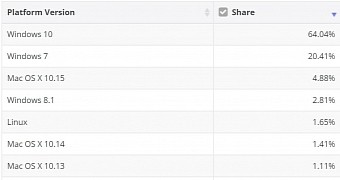Windows 10 was already the number one desktop operating system in the world, but October brought another massive increase, allowing it to further consolidate its lead over all the other competing products.
And according to NetMarketShare data, part of Windows 10’s growth is the result of Windows 7 declining even more, which could thus be an indication that some of those who installed Microsoft’s latest operating system actually come from the 2009 predecessor.
More specifically, Windows 10 was running on 64.04% of the desktop computers out there in October, an increase from 61.26% the month before. Windows 7, on the other hand, dropped to 20.41% from 22.77%, thus reaching a new low after it was retired by Microsoft earlier this year.
Windows 7 is now considered an unsupported platform, and it only receives security patches as part of the ESU program released by Microsoft for paying enterprises. Consumers whose devices are still running Windows 7 aren’t getting any new updates.
Here are the market share stats for the top desktop operating systems last month:
- Windows 10: 64.04%
- Windows 7: 20.41%
- macOS 10.15: 4.88%
- Windows 8.1: 2.81%
- Linux: 1.65%
- Windows XP: 0.87%
- Chrome OS: 0.54%
- Ubuntu: 0.51%
The faster adoption of Windows 10 isn’t necessarily a big surprise for Microsoft, as the company says that the last months brought a major change of trends for its top products, including Windows, Microsoft 365, and Microsoft Teams. This is because more people started working from home, and companies out there migrated to these products in order to allow their employees to remain productive remotely.
Microsoft CEO Satya Nadella himself admitted that the boom recorded by some products is generated by this shift, and he reiterated that Microsoft would continue to invest in Windows in the long term.
“If anything, again, the last nine months or so have proven that when it comes to Windows and PCs, they become mission-critical because when it comes to remote learning, remote work and any type of activity and productivity, in particular, depends on having PCs and applications on PCs. So, we are doubling down on it,” Nadella said.
“That means, the innovation in Windows, and Microsoft 365 is the best way to conceptualize how we even think about Windows because it’s one surface area where we want to deliver our best payloads for productivity, communications, collaboration, business process.”
Worth emphasizing, however, is that Microsoft no longer sees Windows as a stand-alone product, but rather as an entire ecosystem that the company is fully committed to. So in addition to improving the operating system itself, the Redmond-based software giant also wants to continue working with partners to bring more devices to the market, thus consolidating Windows’ lead in the operating system world.
“We’ll keep working even on the form function innovation as well. So, even if you look at the holiday lineup of devices, it’s great to see that, large screens, small screens, mobile, different chip architectures that make it pretty attractive to have a Windows device with you always. So, that’s how we look at it. It’s very important. I think, if anything, even mobile-only countries and mobile-only scenarios are recognizing that they also can do with some help with additional screens,” Nadella noted.
In the meantime, Microsoft is working around the clock not only on refining the desktop experience with Windows, but also to expand it to further devices. The company is now giving the finishing touches to Windows 10X, a new operating system that was originally built with dual-screen devices in mind but which will now make its debut on single-screen devices first. The debut of Windows 10X is projected to happen in the first months of 2021.

 14 DAY TRIAL //
14 DAY TRIAL //